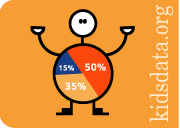The
California Index of Child and Youth Well-Being
..................................................................................................................................................................................................................
|
December 2009 -- Is the overall health and well-being of California's children improving or deteriorating? How has the status of children changed since the 1990s? How might the recent economic downturn affect the future of the state's children? To help answer these critical questions, the Lucile Packard Foundation for Children's Health commissioned Kenneth Land, Ph.D., of Duke University, to create a California Index of Child and Youth Well-Being, summarizing trends over the past decade. The composite index is modeled after Dr. Land's national Child and Youth Well-Being Index (CWI), which has been released annually since 2004 by the New York-based Foundation for Child Development. More>>
![]() What Is an Index of Well-Being?
What Is an Index of Well-Being?
| This graph shows the rate of improvement for the Child and Youth Well-Being Index for California. Overall, child well-being improved by about 16% from 1995 to 2006. |
|
Study:
Full Report | Methodology
|
Summary
Press:
Organizational Backgrounder | Press
Release
Key Results
On the whole, results show that the well-being of children is getting better in California. Using 1995 data as a base year with a score of 100, child well-being in California improved by about 16% from 1995 to 2006.
Other notable findings from this study:
- Child well-being improved for all race/ethnicities that could be examined by available data (African American, Asian, Caucasian, and Latino). However, racial/ethnic disparities persisted over time. African American children, in particular, consistently fared worse than their Caucasians peers during the period studied.
- Children in California saw the biggest gains in the Safety/Behavioral Concerns domain (41% improvement), based on falling juvenile arrest and teen birth rates. But there was a noticeable decline of 21% in the Family Economic Well-Being domain, due to worsening trends in child poverty and housing affordability.
- In an effort to understand how the current economic recession could affect the well-being of children in California, this study also projected child poverty rates over the next few years. These estimates show that poverty may rise from 18.5% of California's children in 2008 to 27% in 2010, before falling to 24% in 2012, meaning the impact of the current economic recession likely will be long-lasting for California's children.



